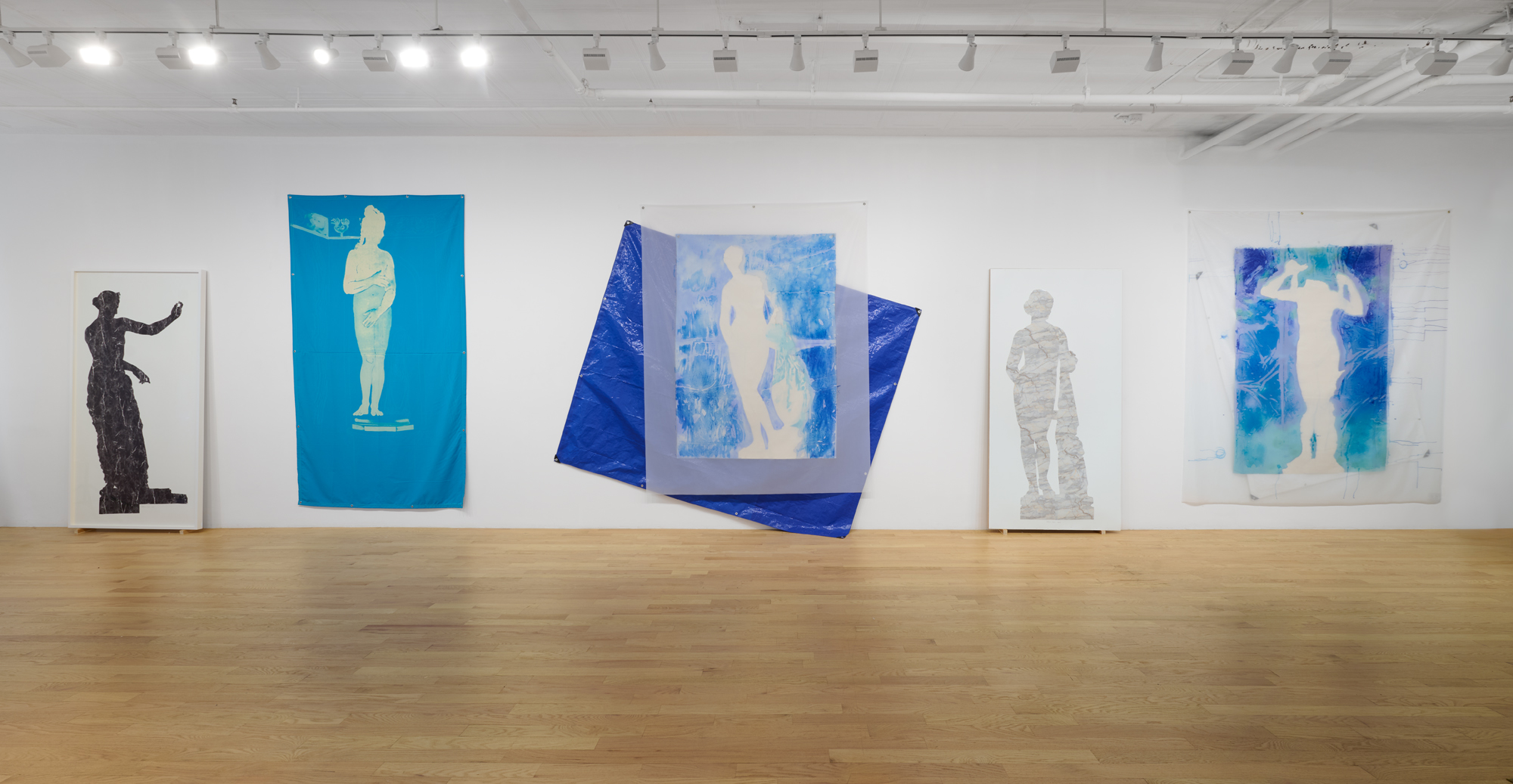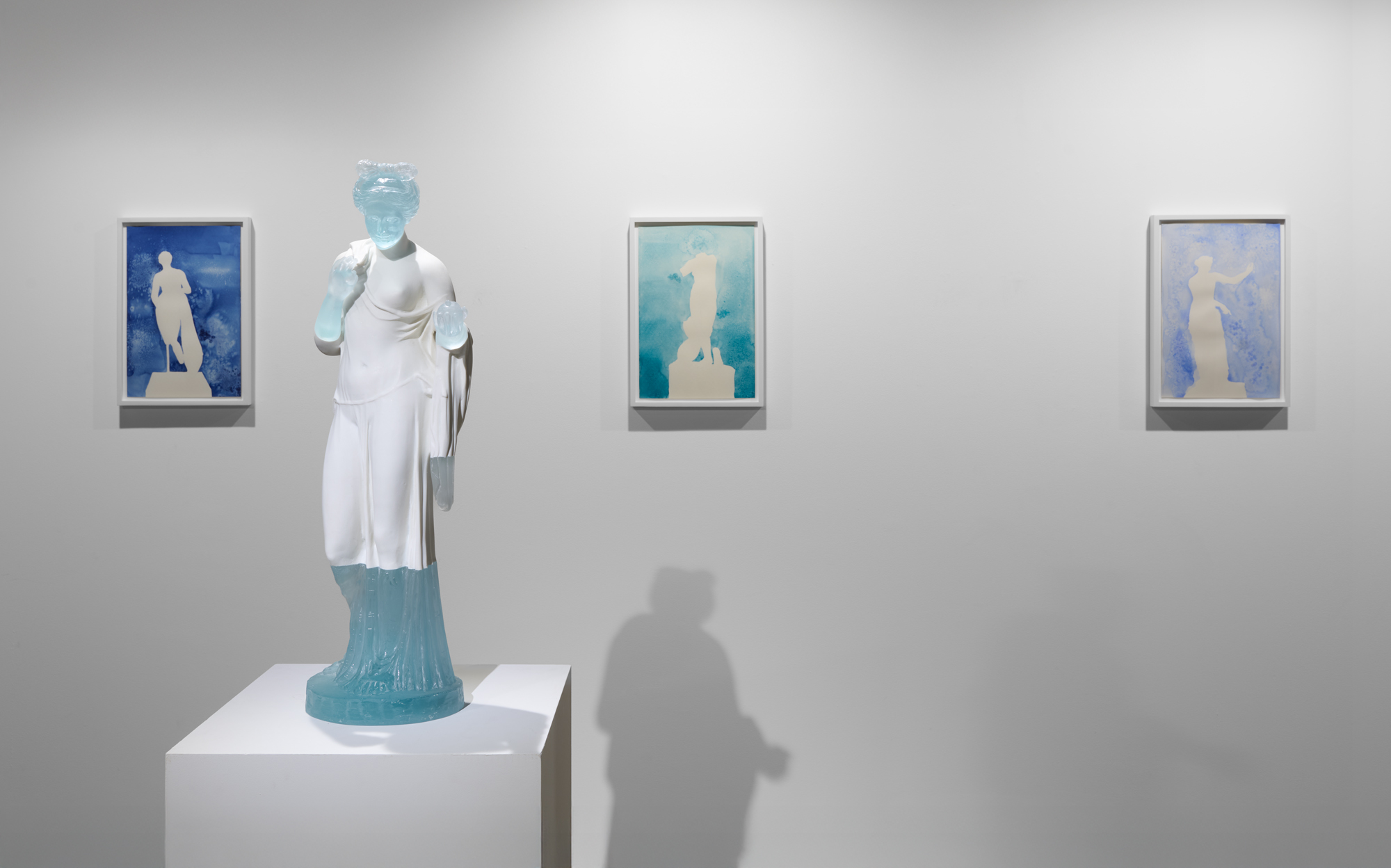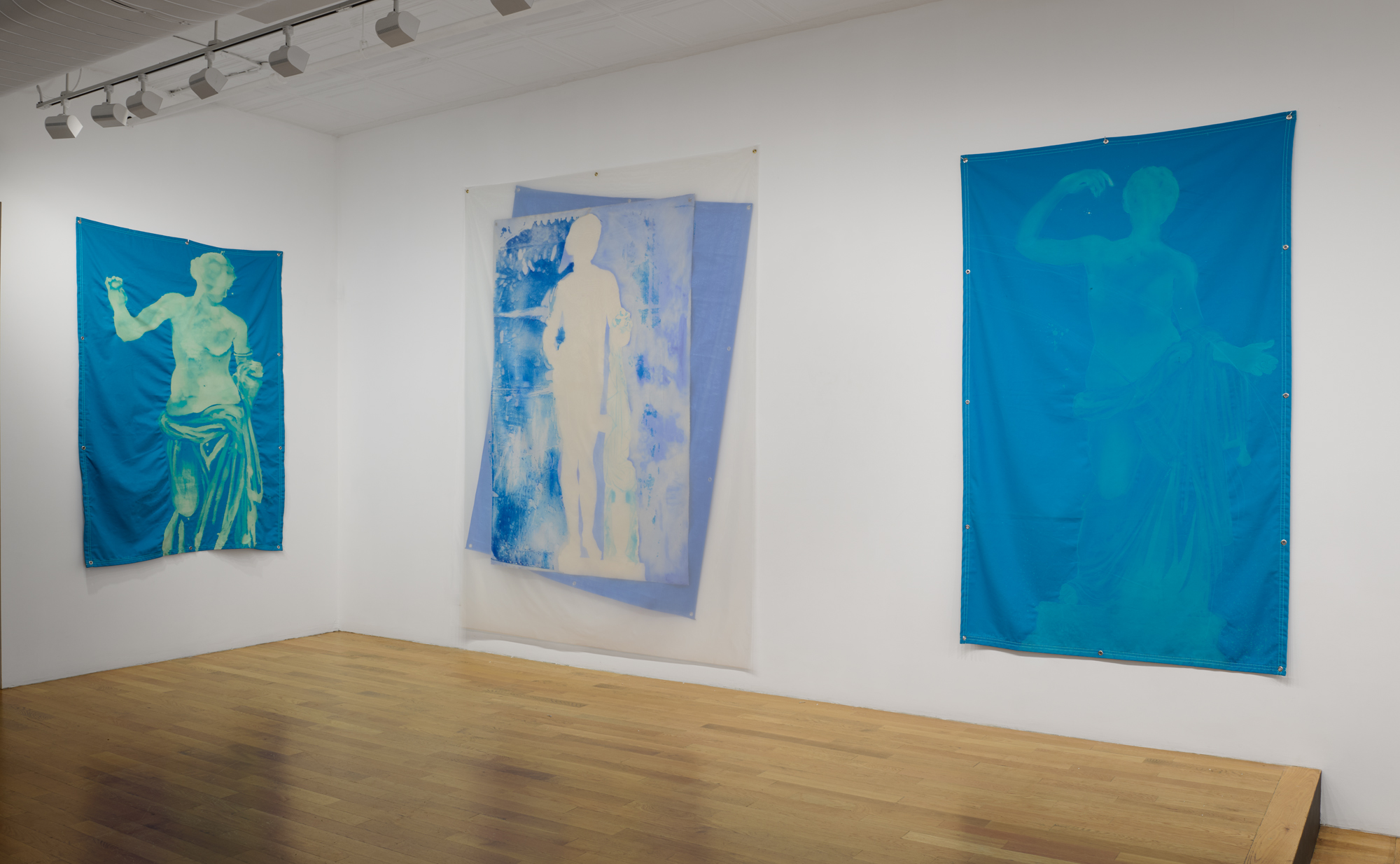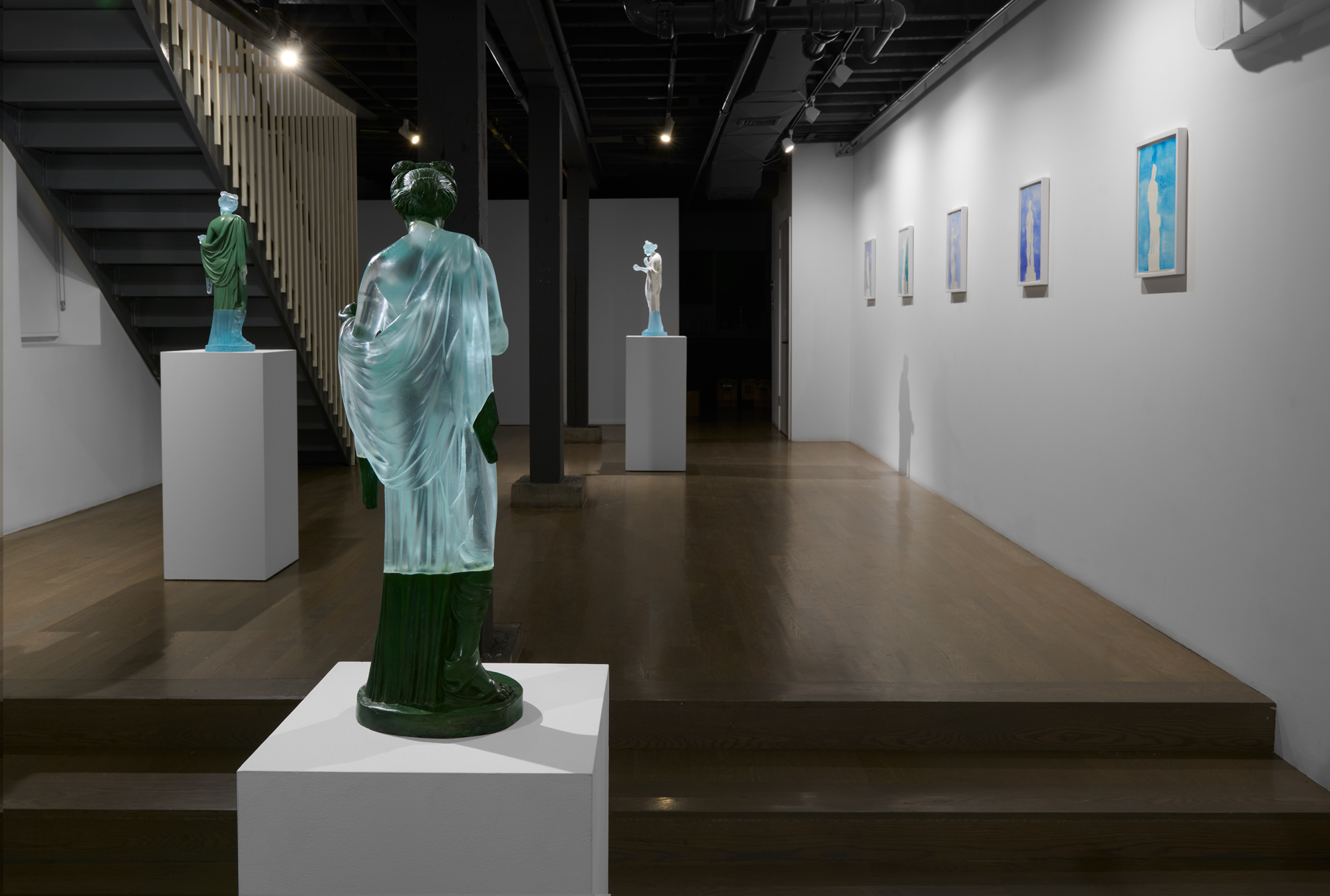
Among the earliest monumental female nudes is Praxiteles’ “Aphrodite of Knidos,” a 4th-century BCE marble statue widely copied and reimagined throughout the ancient world. Ironically, the original was lost to history, surviving only as a ghost haunting countless echoes—from Botticelli’s “The Birth of Venus” to the legendary “Venus de Milo”—thus setting the Western canon for the female form with her sensual contrapposto and suggestive modesty.
Artist Patricia Cronin’s recent body of work joins this long lineage, paying homage to the Goddess of Love, Beauty, and Grace as a heroic figure in a world that rewards hatred, destruction, and indecency.
A striking series of monumental paintings and statuettes, “Army of Love” showed recently at Chart Gallery, a Tribeca space founded by Kasmin alum Clara Ha in 2019 with the curatorial vision of presenting art predominantly by women—notably Cronin’s first solo show in New York in almost a decade.
This isn’t easy or sentimental work—not for the world and not for Cronin. “What is so important to you that you are willing to lose for it? What are you willing to lose for?” she asked me recently as we discussed the crush of political losses sustained by women in the United States, echoing the broader global backlash to progress. This radical acceptance of loss—the willingness to fail, to lose—brings into stark perspective the real grit and determination that love requires. In “Army of Love,” Cronin offers art as a vessel for that determined kind of love: a compulsion as old as humanity itself.
Patricia Cronin as Interviewed by Rachel Dalamangas
Walk me through how the large works were made because as I understand, it was a multi-step process where the materials are impossible to tightly control, with much left to chance and experimental.
In “Army of Love” at Chart Gallery, the multi-layered assemblage paintings are entirely process-based and showcase three ways of paintings all in one. If there is a hierarchy of painting techniques, three are in these works, hand painted, mechanical reproduction, and ready-made objects.
After a research trip to Rome—location of the highest concentration of Aphrodite and Venus statues, many “copies” of the great 4th Century BCE attic sculptor Praxiteles’ “Aphrodite of Knidos” (350 BCE) renowned original onward—I was impatient to work large and dove right in.
Because Aphrodite is born of the sea, oil paint felt wrong. I turned to water-based paints, though I dislike acrylics and had never used them before. On raw, unprimed canvas spread across a plastic-covered table, I painted the negative space around the statues’ silhouettes. When I hung the canvas up to dry on the wall, I turned around and realized that aquamarine, cobalt, and turquoise paint had seeped through the canvas fibers, leaving abstract sea-foam apparitions I couldn’t anticipate or control. That unknowability of what I was making was exhilarating—a liberation that defied the old binaries of abstraction versus representation.
To preserve these ghostly abstractions, I photographed the residue on the plastic sheets and transferred them via dye sublimation onto sheer fabric. Hung on the wall over the painted canvas, the veils hover like apparitions of Aphrodite—always shifting, never fully seen. Behind them hangs a third layer: a ready-made polyethylene tarp, utilitarian and protective, echoing the ship’s sails from the ancient port cities where public and private temples to Aphrodite stood and supplicants prayed to her for safety.
Your work often begins with a kind of excavation of art history, sometimes resurrecting women artists cannibalized by the (heavily) male-dominated canon, and in “Army of Love” a kind of excavation of Praxiteles’ “Aphrodite of Knidos”—lost to history but felt in its influence on every depiction of the Goddess of Love to follow. How does history inspire and inform your work?
History is where I find the best ideas! Knowledge of the past sharpens my understanding of the present and arms me for the future. I always look for what I call “the magic three”: the right image or form, the right materials, to perfectly match the contemporary content burning in my mind for that moment in time.
After the 2016 election, with women being pushed out of public life and our democracy on the brink, the Tampa Museum of Art invited me to be the inaugural artist in their Conversations with the Collection series and respond to their Antiquities Collection. The first object I saw was a headless, limbless 1st-century CE torso of Aphrodite, one of the two most powerful female figures of the Ancient Mediterranean World, the birthplace of democracy. Fragmented by blunt force or centuries of neglect, yet enduring, she became the perfect focus for my imagination.
Praxiteles’ “Knidian Aphrodite,” the first monumental female nude in the western canon, once stood in the Temple to Aphrodite Euploia in Knidos, Turkey. Though the original is long lost, its fame lived on in Pliny’s writings and dozens of copies now housed in major museums around the world. On July 20, 1969—the day man planted a flag on the moon—archaeologist Iris Love, a groundbreaking lesbian, discovered that temple in Knidos. Cosmic conquest above, female divinity unearthed below.
At the same time, the Italian Arte Povera movement was at its height. Its artists embraced humble materials and methods, but most of the celebrated artists were all men. I wanted to shift the frame—introducing domestic materials historically coded as feminine: bleach, salt, tarps, contact paper. In “Army of Love”, classical ideals collide with those overlooked materials, reframing women’s labor and presence in art history.

You’ve referenced something you called the “economy of care.” What is the economy of care as it relates to this exhibit?
In the Ancient Mediterranean World, gods and goddesses held both civic and spiritual authority for their city-states. A powerful deity, Aphrodite was worshiped and beseeched for almost everything, marriages, business contracts, safe voyages, harvests, harmony in the community and the home. Unlike gods of war (although she helped with military victories also), her power was protection through love.
That is the lineage I claim. The tarps—today used to protect what we value when they shield homes after hurricanes—become metaphors for survival. Salt, bleach, and contact paper—tools of the domestic sphere for cooking, cleaning and decor—are monumentalized. In my hands, “army” no longer signals only conquest but an assembly for love, safety, and dignity. Compassion over conflict.
We’re living in a time where relations between men and women seem broken. Even in the political climate, in broad sweeping generalizations, it’s kind of strange to see the difference in how men are reacting and how women are. Sometimes it feels like we really are speaking a different language. How is “Army of Love” responding to the societal breakdown of decency, old against young, man against woman, one people against another, civilization, rationality and objectivity, and the rolling apocalypse that it feels like the world is becoming?
Critiquing misogyny and homophobia have always been at the core of my life’s work, and “Army of Love” continues that fight. As Jimmy Carter once said, “subjugating half your population is not only immoral, it is irrational.”
Today, hard won rights are being stripped away—from women, LGBTQ+ people, immigrants, and people of color. History tells us authoritarian regimes rely on scapegoats. On the first day, the Trump administration’s Executive Order “Defending Women From Gender Ideology Extremism And Restoring Biological Truth To The Federal Government” legally mandated only two genders, and their March 27, 2025 “Restoring Truth and Sanity to American History” Executive Oder targeted the Smithsonian Museums, deeming all art about feminist, LGBTQ+ and African-American history “Un-American Ideology” that “must be eliminated.” This is McCarthyism 2.0. This attack on gender and LGBTQ+ existence, was never just policy—it was ideology designed to erase histories and lives. “Army of Love” resists that erasure, insisting on visibility, protection, and dignity.
It also seems like art by women is increasingly referencing empathy and compassion. Some dismiss these as sentimental, but I think they take enormous discipline and depth. Do you have a definition of compassion or empathy that you were working from for this show?
I believe empathy is at the core of every great artwork. For “Army of Love”, I drew from British Classics Professor Mary Beard’s analysis of Sappho’s sole complete poem “Ode to Aphrodite.” Beard identified that Sappho was echoing Homer in book five of The Iliad, when Diamides prays to the goddess Athena I the midst of battle. By using the same content and stanza structure, Sappho subverts the entire male heroic order by changing men at war to women in love. Sappho might be the first appropriation artist!
That’s what I wanted: to redefine “army” not as a force of domination and destruction, but as a body in the service of protection, care, and compassion.
This is urgent. We live in a culture of government sanctioned cruelty—where the language of “lethality” replaces diplomacy, where white supremacist militias cosplay war on our streets. It is terrifying. And yet, in my studio, I am surrounded by towering female sentinels, and I feel safer. Only in safety can my imagination flourish.
By freeing these canvases from wooden stretchers, letting them flutter like sails, I gave form to liberation itself. Love, empathy, compassion—these are not weak. They are revolutionary. They are the only true antidote to cruelty.
At your studio, I loved seeing the test swatches of blue paint. What are you looking for when you experiment with color?
There are so many blues, and they are all so gorgeous. Aphrodite, being born of the Mediterranean Sea, I needed to do a deep dive into the array of hues. And then the spontaneity of the creative processes, especially with the watercolors made with sea salt, I needed a visual legend, so that while I’m in the middle of creating, I can SEE the color and act, rather than pause, pick up different tubes, and read the names of the blues and then choose.
When you work with watercolor, the pigment binds into the paper simultaneously while water evaporates away from the paper. I add more pigment, more water, and then I throw in Mediterranean sea salt which up ends the curing process. Time is of the essence, and one develops the necessary expert aesthetic calculations over decades of working. There are no short cuts.

I was also thinking about how art asks us to re-orient how we relate to others and ourselves, toward the experiences of someone or something else, familiar and unfamiliar, and by that virtue, the experience of having empathy itself expands our own scope of experience and capacity for perception. How do you hope viewers’ perceptions might expand through encountering your art?
Viewing art is a contemplative experience. And this “Army of Love” series is very open ended. I want people to walk in thinking they know everything they want to know about Aphrodite and encounter paintings that change that perception, slow them down, take them off autopilot, lower their blood pressure, and unplug for a little while. I’ve taken a well-known icon, Aphrodite, the Goddess of Love, Beauty and Sex and hopefully my conceptual choices and material experimentations has produced paintings and sculptures that reveal something they can experience anew and not just validate what they already know. That’s so boring!
The installation at Chart Gallery’s lower-level gallery creates an almost sacred space with a sense of mysticism. How intentional is this atmosphere? What role does the physical environment play in how you want people to experience the work?
Clara Ha, the owner of Chart Gallery, made the curatorial decision to keep all the monumental work upstairs and have all the intimate scaled works in the lower level. We call it the inner sanctum! After walking through the more public cult statue scaled works, viewers descend the stairs to the lower gallery, and you feel you are entering a sacred space. I’ve exhibited and collaborated with religious, secular, and industrial historic spaces, including a cemetery, a church, a villa, and a former powerplant. Creating contemporary art for historic architectural environments must be rigorously and sensitively done, out of respect for the historic space and the art. Anachronistic pairings are a favorite aesthetic strategy for me. These time traveling combinations expand both the original function of the venue and art. It connects us to a longer continuum of art, cultural practices, and humanity. I know we should be asking a lot more of art.

I noticed you used packing foam from a museum replica of Aphrodite to create two glass art works. How do you decide which found or utilitarian materials—like foam, canvas, and tarp—make it into the final work? What draws you to these everyday objects?
I like everyday objects for their transformative properties/potential. I animate them into a dual existence. And that expands their artistic and conceptual impact while also remaining true to their original purpose. My antennas are always on; I see the beauty and the potential in objects others don’t. The tarp is still a tarp, its function—to protect what we value remains the same, but I see its value and want to show others its inherent metaphorical properties. Elevating common domestic or utilitarian materials to the status of art history is a strong feminist statement.
What is the relevance of beauty in a world that is as you say is full of sanctioned cruelty?
Love and beauty are essential to combat and survive the rampant hatred and brutality. We are witnessing a race to the ethical bottom of who can be the most deceitful, the most bombastic, the greediest, the most selfish, the meanest, the most sadistic. The Ancient Greeks believed that beauty and goodness were connected, external physical beauty demonstrated internal moral virtue. While our 21st century selves might bristle at this concept, the beauty of the natural world is unanimously embraced as sites of solace and comfort after the daily barrage of chaos and cruelty. We must hold on to beauty in all its forms, especially now.
Rachel Dalamangas
New York, New York
2025
Image Credits:
KC Crow Maddux
Courtesy Patrica Cronin Studio LLC and CHART, New York
© Patricia Cronin